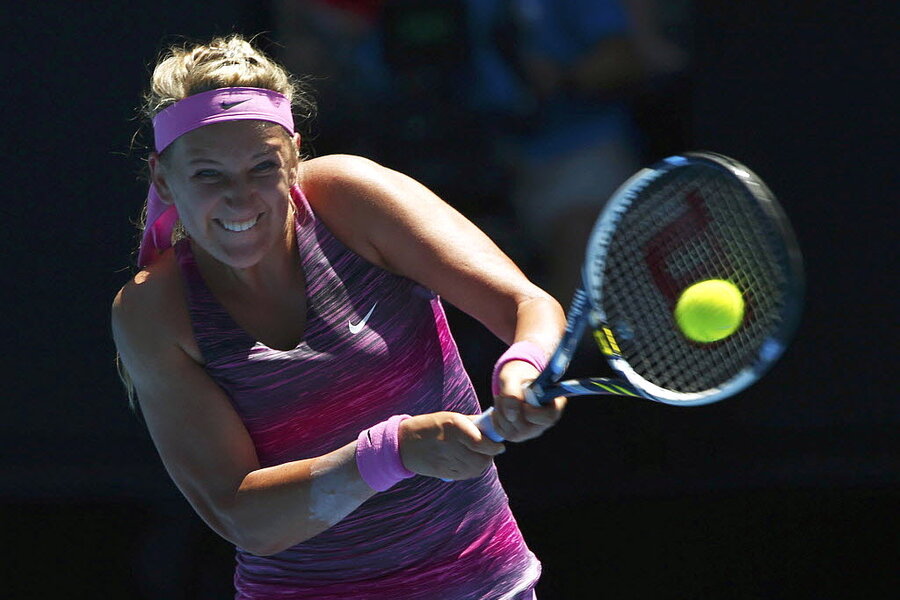Victoria Azarenka wins first game at Australian Open in 100+ weather
Loading...
Preparing to take the court Tuesday at the Australian Open, American Sloane Stephens kept checking the weather app on her phone as she fretted about the temperature.
The number kept climbing, and Stephens updated her coach, Paul Annacone.
"I'm like, 'My phone says 108.' He says, 'No, it can't be.' 'No, I'm pretty sure,'" Stephens recalled later.
Australia's summer heat wave has produced eye-popping, knee-buckling temperatures, and the mercury soared well beyond the century mark on Day 2 of the Grand Slam tournament in Melbourne. While the conditions were remarkable, so was the ability of the world's top players to endure them, undercutting their reputation as coddled complainers.
Touring pros must cope with the frustration of frequent rain delays at Wimbledon. Cool, damp weather often accompanies the French Open's marathon matches. Seasons change from summer to fall during the U.S. Open.
But the heat served up at the Australian Open poses perhaps the most challenging conditions on the Grand Slam circuit.
"It can become just a very mental thing, you know, and you just can't accept that it's hot," Roger Federer said. "Just deal with it, because it's the same for both. That's basically it."
Carolina Wozniacki of Denmark said the plastic on her water bottle began to melt when she set it down on the court during her match. But she said an ice bath helped her recover quickly afterward.
"I could go out and play another two sets now," Wozniacki said. "You know that it's going to be hot. It's Australia."
With more triple-digit temperatures in the forecast for Melbourne, here are five things to know while the heat is on:
SOME CAN TAKE THE HEAT: Victoria Azarenka described her match as "like you're dancing in a frying pan," but when she won, she decided she needed to sweat a little more. So she headed for a practice court. "I just went out straight to go hit — actually put on a long-sleeved shirt," Azarenka said. "It wasn't probably the smartest thing to do, but I'm fine." The Belarusian said she'll back out in the heat Wednesday, even though she has the day off. "Maybe I won't hit for two hours," she said, "but I'm definitely going to go out and, you know, get some more suntan."
GUIDELINES FOR HALTING PLAY: Matches can be stopped and the tournament's two retractable roofs closed at the discretion of tournament director Wayne McKewen. He makes his decision while monitoring the wet bulb globe temperature index, or WBGT, a calibration based on temperature, humidity, wind speed and sunshine. Extreme heat halted plays during several days of the 2006 tournament. The hottest Australian Open on record was in 2009, when the average temperature was 94.46 degrees (34.7 C).
OVEN-LIKE CONDITIONS: McKewen described the weather Tuesday as "uncomfortable" but said he allowed play to continue because the humidity was low. American John Isner said the heat was the sort he feels when he opens his oven. One ball girl was treated for heat stress, and the crowd for the day session was 35,571, almost 12,000 less than on Monday. But while six players dropped out of the tournament Tuesday, none of the departures was linked to the weather. Gilles Simon of France and Daniel Brands of Germany made it through a match lasting 4½ hours, including a 16-14 final set. The high temperature Tuesday was 108, and the forecast calls for highs of 102, 109 and 111 the next three days before the heat wave breaks.
SOME DON'T LIKE IT HOT: Canadian qualifier Frank Dancevic said he blacked out during a three-set loss and described the conditions as dangerous. Reigning Wimbledon champion Andy Murray won easily but questioned whether matches should have been played. "In this heat, that's when you're really pushing it to your limits," Murray said. "You don't want to see anything bad happen to anyone."
NUMBER-CRUNCHING: The focus on the thermometer makes math a valuable skill. Australians uses the Celsius scale, so for them the high temperature Tuesday was 42 — which happened to be when Stephens played, and won. Some well-traveled American players learn how to convert Celsius to Fahrenheit. "Just ask me," Stephens said, "because I've been looking at it all day."
Copyright 2014 The Associated Press. All rights reserved. This material may not be published, broadcast, rewritten or redistributed.







